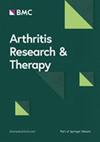Targeting STAT6-mediated synovial macrophage activation improves pain in experimental knee osteoarthritis
IF 4.9
2区 医学
Q1 Medicine
引用次数: 0
Abstract
Pain from osteoarthritis (OA) is one of the top causes of disability worldwide, but effective treatment is lacking. Nociceptive factors are released by activated synovial macrophages in OA, but depletion of synovial macrophages paradoxically worsens inflammation and tissue damage in previous studies. Rather than depleting macrophages, we hypothesized that inhibiting macrophage activation may improve pain without increasing tissue damage. We aimed to identify key mechanisms mediating synovial macrophage activation and test the role of STAT signaling in macrophages on pain outcomes in experimental knee OA. We induced experimental knee OA in rats via knee destabilization surgery, and performed RNA sequencing analysis on sorted synovial tissue macrophages to identify macrophage activation mechanisms. Liposomes laden with STAT1 or STAT6 inhibitors, vehicle (control), or clodronate (depletion control) were delivered selectively to synovial macrophages via serial intra-articular injections up to 12 weeks after OA induction. Treatment effects on knee and hindpaw mechanical pain sensitivity were measured during OA development, along with synovitis, cartilage damage, and synovial macrophage infiltration using histopathology and immunofluorescence. Lastly, crosstalk between drug-treated synovial tissue and articular chondrocytes was assessed in co-culture. The majority of pathways identified by transcriptomic analyses in OA synovial macrophages involve STAT signaling. As expected, macrophage depletion reduced pain, but increased synovial tissue fibrosis and vascularization. In contrast, STAT6 inhibition in macrophages led to marked, sustained improvements in mechanical pain sensitivity and synovial inflammation without worsening synovial or cartilage pathology. During co-culture, STAT6 inhibitor-treated synovial tissue had minimal effects on healthy chondrocyte gene expression, whereas STAT1 inhibitor-treated synovium induced changes in numerous cartilage turnover-related genes. These results suggest that STAT signaling is a major mediator of synovial macrophage activation in experimental knee OA. STAT6 may be a key mechanism mediating the release of nociceptive factors from macrophages and the development of mechanical pain sensitivity. Whereas therapeutic depletion of macrophages paradoxically increases inflammation and fibrosis, blocking STAT6-mediated synovial macrophage activation may be a novel strategy for OA-pain management without accelerating tissue damage.靶向 STAT6 介导的滑膜巨噬细胞活化可改善实验性膝骨关节炎的疼痛症状
骨关节炎(OA)引起的疼痛是导致全球残疾的主要原因之一,但却缺乏有效的治疗方法。OA 中的痛觉因子由活化的滑膜巨噬细胞释放,但在之前的研究中,耗竭滑膜巨噬细胞反而会加重炎症和组织损伤。我们假设,与其消耗巨噬细胞,不如抑制巨噬细胞的活化,从而在不增加组织损伤的情况下改善疼痛。我们旨在确定介导滑膜巨噬细胞活化的关键机制,并测试巨噬细胞中的 STAT 信号对实验性膝关节 OA 疼痛结果的作用。我们通过膝关节脱位手术诱导大鼠进行实验性膝关节OA,并对分选的滑膜组织巨噬细胞进行RNA测序分析,以确定巨噬细胞的活化机制。在诱导大鼠患 OA 12 周后,通过连续关节内注射,将含有 STAT1 或 STAT6 抑制剂、载体(对照组)或氯膦酸盐(消耗对照组)的脂质体选择性地输送到滑膜巨噬细胞。通过组织病理学和免疫荧光法测量了治疗对膝关节和后掌机械痛敏感性的影响,以及滑膜炎、软骨损伤和滑膜巨噬细胞浸润的影响。最后,在共培养中评估了药物处理过的滑膜组织与关节软骨细胞之间的串扰。通过转录组分析发现,OA滑膜巨噬细胞中的大多数通路都涉及STAT信号转导。不出所料,巨噬细胞耗竭会减轻疼痛,但会增加滑膜组织纤维化和血管化。相反,抑制巨噬细胞中的 STAT6 可明显、持续地改善机械性疼痛敏感性和滑膜炎症,而不会恶化滑膜或软骨病理学。在共培养过程中,STAT6 抑制剂处理过的滑膜组织对健康软骨细胞基因表达的影响微乎其微,而 STAT1 抑制剂处理过的滑膜则诱导了许多软骨更替相关基因的变化。这些结果表明,STAT 信号传导是实验性膝关节 OA 中滑膜巨噬细胞活化的主要介质。STAT6可能是介导巨噬细胞释放痛觉因子和发展机械痛敏感性的关键机制。治疗性消耗巨噬细胞会增加炎症和纤维化,而阻断 STAT6 介导的滑膜巨噬细胞活化可能是治疗 OA 疼痛的一种新策略,同时不会加速组织损伤。
本文章由计算机程序翻译,如有差异,请以英文原文为准。
求助全文
约1分钟内获得全文
求助全文
来源期刊

Arthritis Research & Therapy
RHEUMATOLOGY-
CiteScore
8.60
自引率
2.00%
发文量
261
审稿时长
14 weeks
期刊介绍:
Established in 1999, Arthritis Research and Therapy is an international, open access, peer-reviewed journal, publishing original articles in the area of musculoskeletal research and therapy as well as, reviews, commentaries and reports. A major focus of the journal is on the immunologic processes leading to inflammation, damage and repair as they relate to autoimmune rheumatic and musculoskeletal conditions, and which inform the translation of this knowledge into advances in clinical care. Original basic, translational and clinical research is considered for publication along with results of early and late phase therapeutic trials, especially as they pertain to the underpinning science that informs clinical observations in interventional studies.
 求助内容:
求助内容: 应助结果提醒方式:
应助结果提醒方式:


